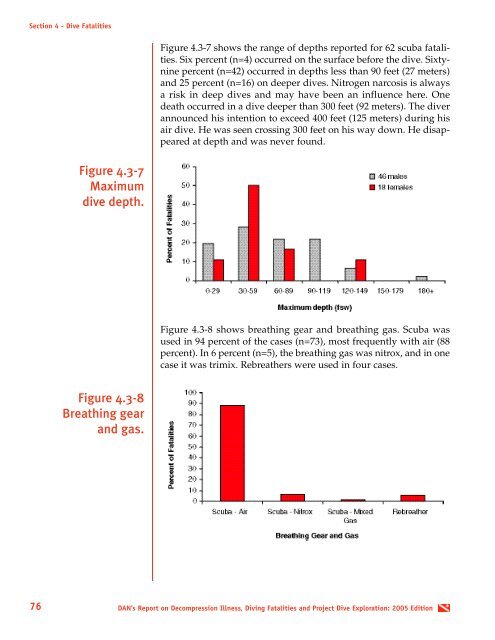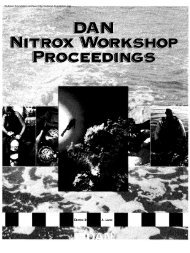Report on Decompression Illness, Diving Fatalities and Project Dive
Report on Decompression Illness, Diving Fatalities and Project Dive
Report on Decompression Illness, Diving Fatalities and Project Dive
- No tags were found...
Create successful ePaper yourself
Turn your PDF publications into a flip-book with our unique Google optimized e-Paper software.
Secti<strong>on</strong> 4 - <strong>Dive</strong> <strong>Fatalities</strong>Figure 4.3-7 shows the range of depths reported for 62 scuba fatalities.Six percent (n=4) occurred <strong>on</strong> the surface before the dive. Sixtyninepercent (n=42) occurred in depths less than 90 feet (27 meters)<strong>and</strong> 25 percent (n=16) <strong>on</strong> deeper dives. Nitrogen narcosis is alwaysa risk in deep dives <strong>and</strong> may have been an influence here. Onedeath occurred in a dive deeper than 300 feet (92 meters). The diverannounced his intenti<strong>on</strong> to exceed 400 feet (125 meters) during hisair dive. He was seen crossing 300 feet <strong>on</strong> his way down. He disappearedat depth <strong>and</strong> was never found.Figure 4.3-7Maximumdive depth.Figure 4.3-8 shows breathing gear <strong>and</strong> breathing gas. Scuba wasused in 94 percent of the cases (n=73), most frequently with air (88percent). In 6 percent (n=5), the breathing gas was nitrox, <strong>and</strong> in <strong>on</strong>ecase it was trimix. Rebreathers were used in four cases.Figure 4.3-8Breathing gear<strong>and</strong> gas.76DAN’s <str<strong>on</strong>g>Report</str<strong>on</strong>g> <strong>on</strong> Decompressi<strong>on</strong> <strong>Illness</strong>, <strong>Diving</strong> <strong>Fatalities</strong> <strong>and</strong> <strong>Project</strong> <strong>Dive</strong> Explorati<strong>on</strong>: 2005 Editi<strong>on</strong>
















